Search
- Page Path
-
- HOME
- Search
- Original Article
- Fecal microbiome profiles in infants with biliary atresia versus nonbiliary atresia cholestasis: a pilot study
- Nur Azizah, Fadilah Fadilah, Silvia Werdhy Lestari, Muzal Kadim, Fithriyah Sjatha, Hanifah Oswari
-
Background: Cholestasis is characterized by disrupted bile flow and can lead to severe liver disease in newborns, of which biliary atresia (BA) is a common cause. The gut microbiome plays a crucial role in aggravating liver injury in BA and non-BA cholestasis. However, information is lacking regarding the differences in gut microbiome composition between patients with BA and non-BA cholestasis.
Purpose:... -
DOI: https://doi.org/10.3345/cep.2025.00563 [Accepted]
- Evolving treatment strategies for invasive Streptococcus pyogenes in children in the postpandemic era
- Laura Buricchi, Giuseppe Indolfi, Marco Renni, Elisabetta Venturini, Luisa Galli, Elena Chiappini
-
Background: Streptococcus pyogenes (group A Streptococcus [GAS]) is a common cause of bacterial pharyngitis and skin infections in children that can lead to severe and invasive GAS (iGAS) infections. The sudden acute respiratory syndrome coronavirus 2 pandemic coincided with an increase in iGAS cases, with emerging serotypes and risk factors like age, reduced postpandemic immunity, and viral coinfections. The treatment... -
DOI: https://doi.org/10.3345/cep.2025.00479 [Accepted]
- Role of neutrophil elastase in predicting infection among children with chemotherapy-induced febrile neutropenia
- Mahmoud A. El-Hawy, Doaa M. Elian, Mai El-Sayad Abd El-Hamid, Esraa T. Allam, Mariam S. Kandeel, Asmaa A. Mahmoud
-
Background: Infection is a significant cause of death following chemotherapy-induced febrile neutropenia (FN). Neutropenia and compromised neutrophil function are the primary reasons for the decreased defense against infections.
Purpose: This study aimed to evaluate the significance of neutrophil elastase (NE) in predicting the outcomes of childhood hematological malignancies with FN. Methods: The study included 64 patients with FN and 64 healthy children... -
DOI: https://doi.org/10.3345/cep.2025.00318 [Epub ahead of print]
- Pulmonology
- Effect of vitamin C supplement in treatment of childhood pneumonia requiring hospitalization: a randomized controlled trial
- Chutima Phuaksaman, Katechan Jampachaisri, Klaita Srisingh
- Clin Exp Pediatr. 2025;68(9):690-699. Published online April 1, 2025
-

This study assessed the effects of vitamin C on children with community-acquired pneumonia (CAP). Vitamin C supplementation improved clinical symptoms within 48–72 hours compared to placebo but did not reduce the length of hospital stay (LOS). These findings suggest that vitamin C is beneficial for managing CAP severity, but does not affect LOS.
- Review Article
- Infection
- Incidence, causative organisms, and risk factors of bloodstream infections in pediatric liver transplant patients: a systematic review
- Mohamad Shieb, Rand Hasanain, Zara Arshad, Faisal A. Nawaz, Rahul Kashyap, Eric J. Stern
- Clin Exp Pediatr. 2024;67(9):427-434. Published online April 5, 2024
-

The overall incidence of bloodstream infections was 23.5%. Gram-negative organisms occur at a much higher rate in pediatric liver transplant recipients then that the general pediatric population. However, when comparing pediatric and adult liver transplant recipients Gram-positive organisms occur with a much higher rate in the pediatric population highlighting the importance of early and broad spectrum antimicrobial coverage when bloodstream infections are suspected.
- COVID-19 among infants: key clinical features and remaining controversies
- Nevio Cimolai
- Clin Exp Pediatr. 2024;67(1):1-16. Published online November 27, 2023
-
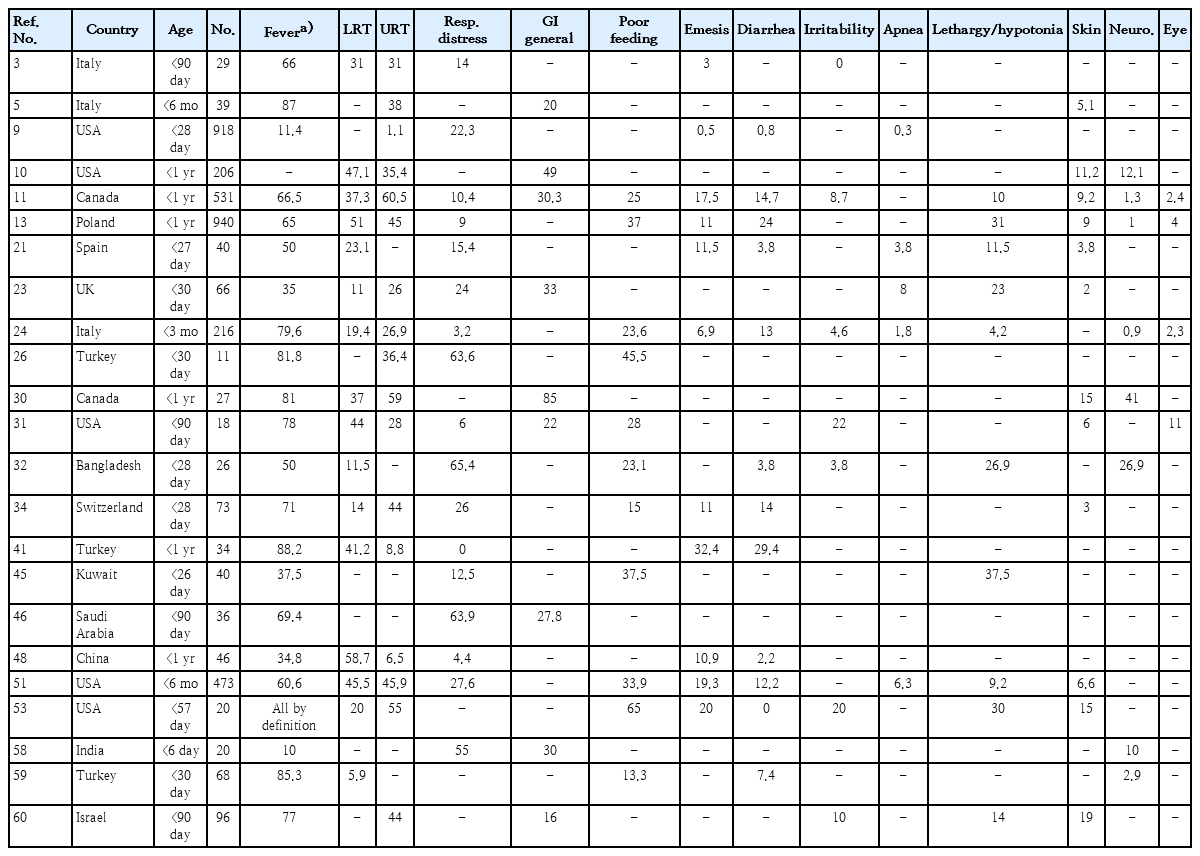
· Clinical studies of coronavirus disease 2019 (COVID-19) in infants should be supported by rigorous laboratory diagnostic criteria.
· Severe acute respiratory syndrome coronavirus 2 (SARS-CoV-2) spreads to infants similarly to other viral respiratory infections.
· Among infants ≤1 year of age beyond the immediate postpartum period, COVID-19 is relatively mild, but even the low risk of severe disease requires prevention.
· Comorbidities increase infection vulnerability and complications in infants.
· Clinical and laboratory data do not sufficiently distinguish COVID-19 from other respiratory viral infections.
· Coinfection with SARS-CoV-2 is uncommon among infants.
· Unique infection sequelae, including multi-inflammatory syndrome in children and neonates and long COVID require further study and refinement of diagnostic criteria.
· Infection control standards applied to mother-infant dyads should be tempered by standard preventive strategies, maternal input, accommodation potential, and overall safety.
· Maternal vaccination prevents disease in early infancy.
- Neonatology (Perinatology)
- Treatment of congenital cytomegalovirus infection
- Gyu Hong Shim
- Clin Exp Pediatr. 2023;66(9):384-394. Published online December 28, 2022
-
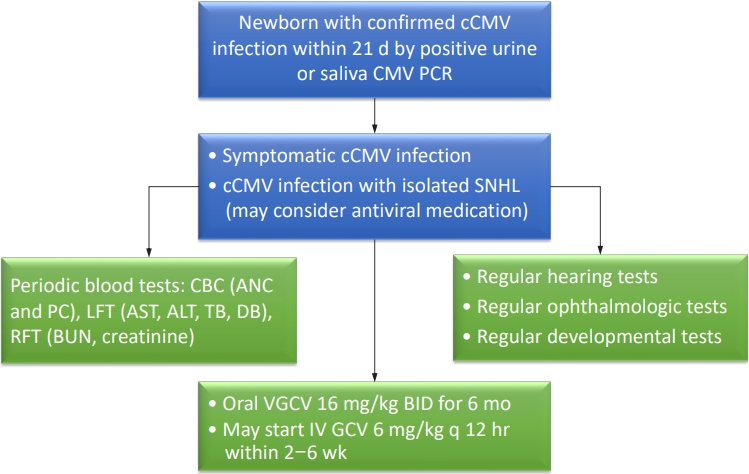
· Congenital cytomegalovirus (CMV) infection is among the most common causes of nongenetic sensorineural hearing loss.
· Congenital CMV is initially treated with intravenous ganciclovir for 2–6 weeks and switched to oral valganciclovir, or with oral valganciclovir for the entire 6-month period.
· Infants with congenital CMV require periodic monitoring of absolute neutrophil count, platelet count, and blood urea nitrogen, creatinine, liver function tests, audiological, ophthalmological, and developmental tests during antiviral medication.
- Cardiology
- Research trends on causes of Kawasaki disease in the COVID-19 era: focus on viral infections
- Young Hwan Lee
- Clin Exp Pediatr. 2023;66(1):1-11. Published online June 22, 2022
-
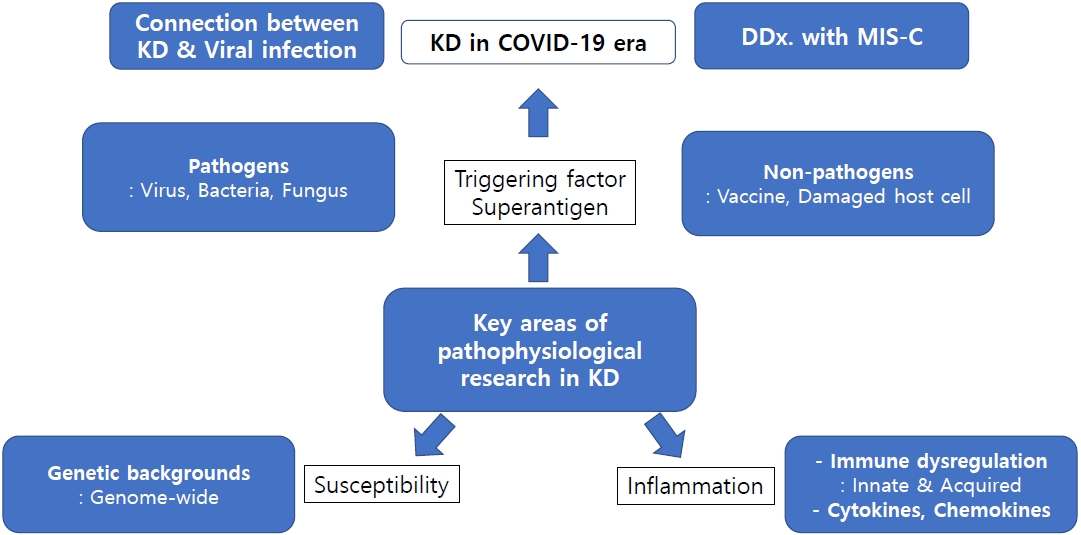
· The etiology of Kawasaki disease (KD) is unclear, but its clinical, epidemiological, and pathophysiological characteristics are strongly associated with infectious diseases.
· In the coronavirus disease 2019 pandemic era, viruses are attracting the most attention. Sudden acute respiratory syndrome coronavirus 2 infection causes various hyperinflammation in children that require differentiation from KD.
· Immune responses in patients with KD may be induced by host cell damage. To effectively prevent and treat KD, the genetic background and immune responses of KD patients and triggering pathogens require identification.
- Original Article
- Emergency Medicine
- Comparison of clinical features and laboratory findings of coronavirus disease 2019 and influenza A and B infections in children: a single-center study
- Meraj Siddiqui, Ayşe Gültekingil, Oğuz Bakırcı, Nihal Uslu, Esra Baskın
- Clin Exp Pediatr. 2021;64(7):364-369. Published online May 18, 2021
-

Question: What are the differences between coronavirus disease 2019 (COVID-19) and influenza infections in children?
Finding: Pediatric COVID-19 patients predominantly exhibited respiratory and/or gastrointestinal symptoms, neurological manifestations, olfactory/gustatory dysfunction, elevated monocytes, mildly elevated C-reactive protein, and unilateral or diffuse abnormalities on chest x-ray. Patients with underlying medical conditions had higher intensive care unit admission rates and should be followed closely.
Meaning: The clinical presentations of pediatric COVID-19 patients varied from asymptomatic/mild to severe.
- Review Article
- Infection
- Effects of nasopharyngeal microbiota in respiratory infections and allergies
- Hyun Mi Kang, Jin Han Kang
- Clin Exp Pediatr. 2021;64(11):543-551. Published online April 15, 2021
-

· The nasal microbiota varies with age and is shaped by various factors in healthy individuals.
· The pathological condition of the respiratory tract appears to be associated with reduced nasal microbiota biodiversity, while dysbiosis is involved in the pathophysiology of many respiratory diseases, including otitis, sinusitis, allergic diseases, and lower respiratory infections.
- Original Article
- General Pediatrics
- Risk factors for childhood pneumonia: a case-control study in a high prevalence area in Indonesia
- Vivi Ninda Sutriana, Mei Neni Sitaresmi, Abdul Wahab
- Clin Exp Pediatr. 2021;64(11):588-595. Published online March 15, 2021
-
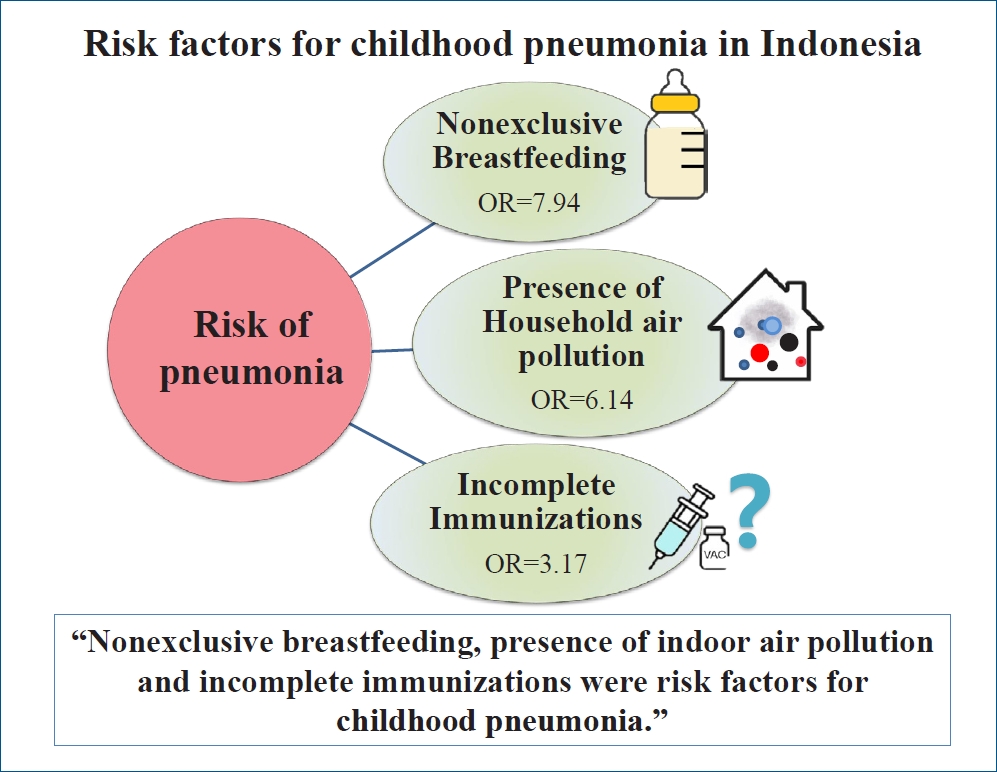
Question: Is the incidence of childhood pneumonia influenced by breastfeeding and basic immunization status?
Finding: Exclusive breastfeeding and complete basic immunization status have an effect in limiting the incidence of childhood pneumonia.
Meaning: While exclusive breastfeeding and complete basic immunization the Expanded Program on Immunization status are important factors for reducing the incidence of childhood pneumonia, indoor air pollution was also a significant risk factor.
- Nephrology (Genitourinary)
- Urinary neutrophil gelatinase-associated lipocalin: a marker of urinary tract infection among febrile children
- Ji Hyun Moon, Kee Hwan Yoo, Hyung Eun Yim
- Clin Exp Pediatr. 2021;64(7):347-354. Published online October 17, 2020
-
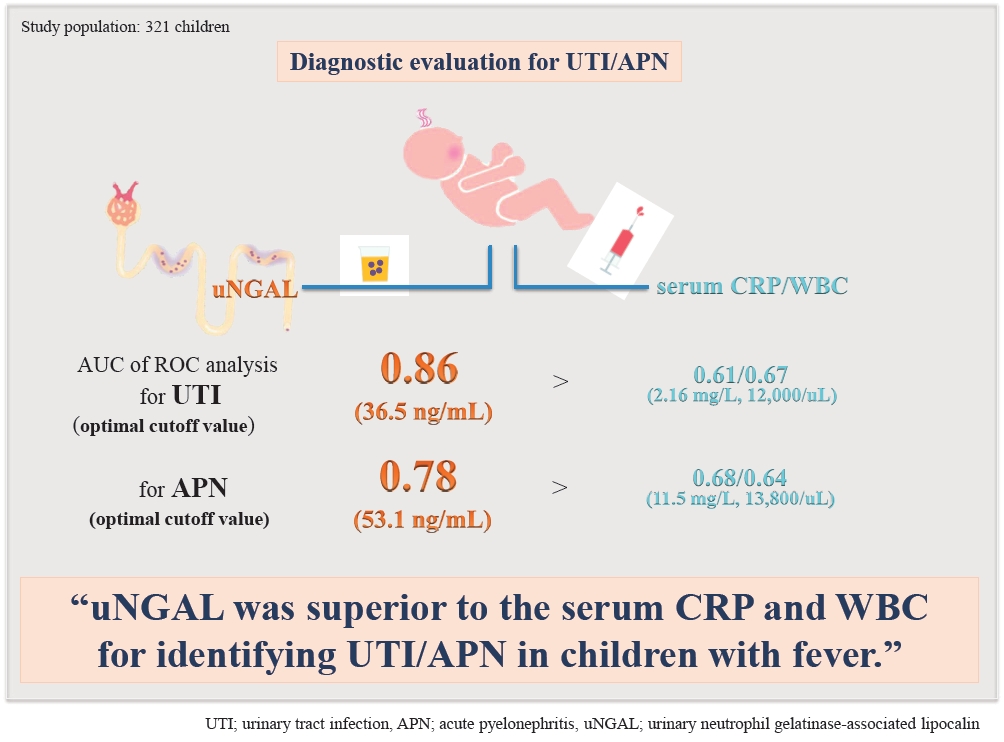
Question: Reliably diagnosing urinary tract infection (UTI) in febrile children is often difficult. Can urinary neutrophil gelatinase-associated lipocalin (uNGAL) better predict UTI and acute pyelonephritis (APN) than serum C-reactive protein (CRP) and white blood cell (WBC) count?
Finding: uNGAL better facilitated the prediction of UTI and APN, than serum CRP and WBC counts in febrile children.
Meaning: uNGAL is a suitable biomarker for UTI and APN in febrile children.
- Review Article
- Gastroenterology
- Changing prevalence of Helicobacter pylori infection in children and adolescents
- Ji Sook Park, Jin Su Jun, Ji-Hyun Seo, Hee-Shang Youn, Kwang-Ho Rhee
- Clin Exp Pediatr. 2021;64(1):21-25. Published online July 15, 2020
-
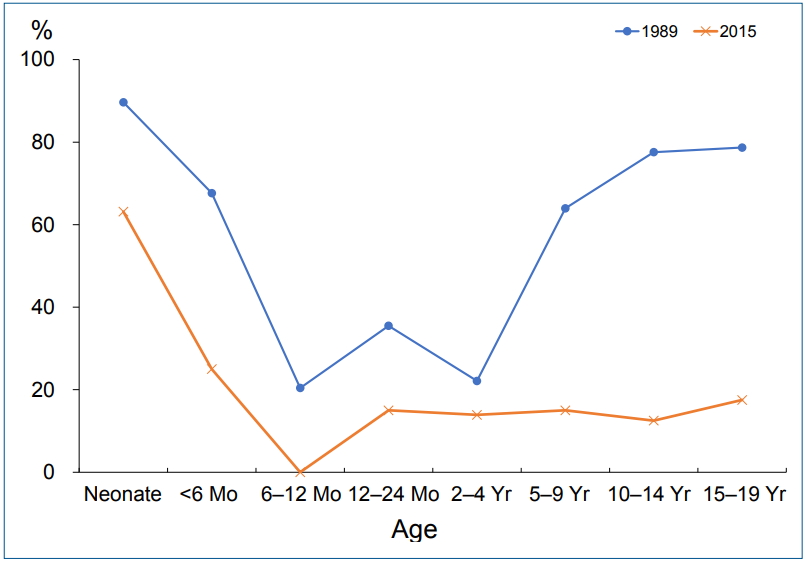
Although Helicobacter pylori infection rate in children is unclear due to diversity and limitation of diagnostic tests unlike in adults, investigation the childhood prevalence is important for predicting H. pylori-related diseases in the future.
H. pylori infection occurred in early childhood, and declined during 30 years in our study.
Change in risk factors of H. pylori transmission and consensus for eradication therapy in children might further reduce the infection rate.
- Original Article
- Critical Care Medicine
- Can central venous access device care bundles and regular feedback reduce central line-associated complications in pediatric patients?
- Chanapai Chaiyakulsil, Onsuthi Pharadornuwat
- Clin Exp Pediatr. 2021;64(3):123-129. Published online July 14, 2020
-

Question: Can central line bundles and feedback reduce central line-associated complications in pediatric patients?
Finding: The central line-related bloodstream infection rate decreased from 10.0 catheter-days to 1.4/1,000 catheter-days at 6-month postintervention. The central line occlusion rate was also decreased.
Meaning: Reinforcing central line care bundles with direct feedback can significantly decrease central line-associated complications in pediatric patients.
- Nutrition
- Positive association of breastfeeding on respiratory syncytial virus infection in hospitalized infants: a multicenter retrospective study
- Min Jeong Jang, Yong Joo Kim, Shinhye Hong, Jaeyoon Na, Jong Hee Hwang, Son Moon Shin, Young Min Ahn
- Clin Exp Pediatr. 2020;63(4):135-140. Published online November 12, 2019
-
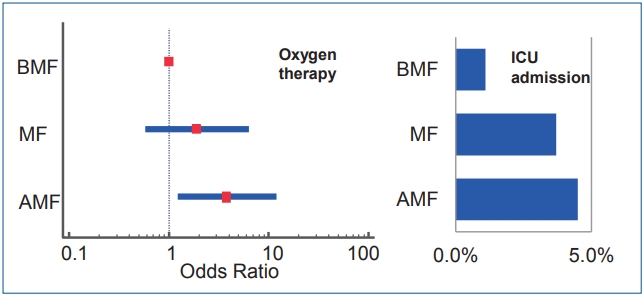
Question: Human milk has stronger antiviral, antibacterial, and anti-inflammatory properties compared with formula milk. How dose breastfeeding affect respiratory syncytial virus infection in Korea?
Finding: Breastfed infants required less oxygen therapy and possible intensive care unit admission than artificial formulafed infants during respiratory syncytial virus infection.
Meaning: This protective role of breast milk on RSV severity can be a supporting evidence for promoting breastfeeding in Korea.
- Cardiology
- High antistreptolysin O titer is associated with coronary artery lesions in patients with Kawasaki disease
- Dong Eun Min, Do Hee Kim, Mi Young Han, Sung Ho Cha, Kyung Lim Yoon
- Clin Exp Pediatr. 2019;62(6):235-239. Published online November 7, 2018
-

Purpose: In Kawasaki disease (KD) patients, coronary artery complications, incomplete and refractory types occur more frequently in patients with streptococcal or other bacterial/viral infections. Recently, we observed a higher incidence of coronary lesions in KD patients with high anti-streptolysin O (ASO) titer. Therefore, we hypothesized that KD patients diagnosed with concurrent streptococcal infection have poor prognosis, with respect to treatment...
- Pulmonology
- The changes of prevalence and etiology of pediatric pneumonia from National Emergency Department Information System in Korea, between 2007 and 2014
- Eun Ju Shin, Yunsun Kim, Jin-Young Jeong, Yu Mi Jung, Mi-Hee Lee, Eun Hee Chung
- Clin Exp Pediatr. 2018;61(9):291-300. Published online September 15, 2018
-

Purpose: Understanding changes in pathogen and pneumonia prevalence among pediatric pneumonia patients is important for the prevention of infectious diseases. Methods: We retrospectively analyzed data of children younger than 18 years diagnosed with pneumonia at 117 Emergency Departments in Korea between 2007 and 2014. Results: Over the study period, 329,380 pediatric cases of pneumonia were identified. The most frequent age group was...
- Infection
- Association between vitamin D and urinary tract infection in children
- Abolfazl Mahyar, Parviz Ayazi, Sara Safari, Reza Dalirani, Amir Javadi, Shiva Esmaeily
- Clin Exp Pediatr. 2018;61(3):90-94. Published online March 19, 2018
-
Purpose The present study aimed to determine the relationship between serum 25-hydroxyvitamin D (25(OH)D) level and Urinary tract infections (UTIs) in children.
Methods In this case-control study, 70 children with UTI (case group) were compared with 70 healthy children (control group) in terms of serum 25(OH)D levels. The children were between 1 month and 12 years of age. Serum 25(OH)D levels were measured...
- Cardiology
- Discrimination of Kawasaki disease with concomitant adenoviral detection differentiating from isolated adenoviral infection
- Jong Han Kim, Hye Ree Kang, Su Yeong Kim, Ji-Eun Ban
- Clin Exp Pediatr. 2018;61(2):43-48. Published online February 28, 2018
-
Purpose Human adenovirus infection mimics Kawasaki disease (KD) but can be detected in KD patients. The aim of this study was to determine the clinical differences between KD with adenovirus infection and only adenoviral infection and to identify biomarkers for prediction of adenovirus-positive KD from isolated adenoviral infection.
Methods A total of 147 patients with isolated adenovirus were identified by quantitative polymerase chain...
- Nephrology (Genitourinary)
- Diagnostic accuracy of urinary biomarkers in infants younger than 3 months with urinary tract infection
- Nani Jung, Hye Jin Byun, Jae Hyun Park, Joon Sik Kim, Hae Won Kim, Ji Yong Ha
- Clin Exp Pediatr. 2018;61(1):24-29. Published online January 22, 2018
-
Purpose The aim of this study was to evaluate the diagnostic accuracy of urinary biomarkers, such as neutrophil gelatinase-associated lipocalin (uNGAL) and β-2 microglobulin (uB2MG), in early detection of urinary tract infection (UTI) in infants aged <3 months with fever.
Methods A total of 422 infants aged <3 months (male:female=267:155; mean age, 56.4 days), who were admitted for fever, were retrospectively included in...
- Is vaginal reflux associated with urinary tract infection in female children under the age of 36 months?
- Yu Bin Kim, Chih Lung Tang, Ja Wook Koo
- Clin Exp Pediatr. 2018;61(1):17-23. Published online January 22, 2018
-
Purpose To determine the relationship between vaginal reflux (VR) and urinary tract infection (UTI) in female children aged <36 months.
Methods A single center retrospective study was performed for 191 girls aged <36 months, with a diagnosis of febrile UTI, who underwent a voiding cystourethrography (VCUG) for assessment of vesicoureteral reflux (VUR) at Sanggye Paik Hospital. Fifty-one girls, who underwent VCUG for assessment...
- Infection
- Uropathogenic
Escherichia coli ST131 in urinary tract infections in children - Ki Wook Yun, Mi-Kyung Lee, Wonyong Kim, In Seok Lim
- Clin Exp Pediatr. 2017;60(7):221-226. Published online July 31, 2017
-
Purpose Escherichia coli sequence type (ST) 131, a multidrug-resistant clone causing extraintestinal infections, has rapidly become prevalent worldwide. However, the epidemiological and clinical features of pediatric infections are poorly understood. We aimed to explore the characteristics of ST131Escherichia coli isolated from Korean children with urinary tract infections.Methods We examined 114 uropathogenic
E. coli (UPEC) isolates from children hospitalized at Chung-Ang University...
- Cardiology
- Clinical usefulness of serum procalcitonin level in distinguishing between Kawasaki disease and other infections in febrile children
- Na Hyun Lee, Hee Joung Choi, Yeo Hyang Kim
- Clin Exp Pediatr. 2017;60(4):112-117. Published online April 25, 2017
-

Purpose The aims of this study were to compare serum procalcitonin (PCT) levels between febrile children with Kawasaki disease (KD) and those with bacterial or viral infections, and assess the clinical usefulness of PCT level in predicting KD.
Methods Serum PCT levels were examined in febrile pediatric patients admitted between August 2013 and August 2014. The patients were divided into 3 groups as...
- Infection
- Etiology and clinical characteristics of fever of unknown origin in children: a 15-year experience in a single center
- Yi-Seul Kim, Kyung-Ran Kim, Ji-Man Kang, Jong-Min Kim, Yae-Jean Kim
- Clin Exp Pediatr. 2017;60(3):77-85. Published online March 27, 2017
-

Purpose Fever is one of the most common symptoms in children. In previous studies, infectious disease was the most common cause of pediatric fever of unknown origin (FUO). The aim of this study is to investigate the etiology, clinical characteristics and prognosis of pediatric FUO in 21 century with more diagnostics available and to analyze the factors for certain disease categories.
Methods Among...
- Usefulness of interferon-γ release assay for the diagnosis of latent tuberculosis infection in young children
- Ki Wook Yun, Young Kwang Kim, Hae Ryun Kim, Mi Kyung Lee, In Seok Lim
- Clin Exp Pediatr. 2016;59(6):256-261. Published online June 30, 2016
-
Purpose Latent tuberculosis infection (LTBI) in young children may progress to severe active tuberculosis (TB) disease and serve as a reservoir for future transmission of TB disease. There are limited data on interferon-γ release assay (IGRA) performance in young children, which our research aims to address by investigating the usefulness of IGRA for the diagnosis of LTBI.
Methods We performed a tuberculin skin...
- Nephrology (Genitourinary)
- Usefulness of neutrophil-lymphocyte ratio in young children with febrile urinary tract infection
- Song Yi Han, I Re Lee, Se Jin Park, Ji Hong Kim, Jae Il Shin
- Clin Exp Pediatr. 2016;59(3):139-144. Published online March 31, 2016
-
Purpose Acute pyelonephritis (APN) is a serious bacterial infection that can cause renal scarring in children. Early identification of APN is critical to improve treatment outcomes. The neutrophil-lymphocyte ratio (NLR) is a prognostic marker of many diseases, but it has not yet been established in urinary tract infection (UTI). The aim of this study was to determine whether NLR is a...
- Evaluation of new American Academy of Pediatrics guideline for febrile urinary tract infection
- Da Min Choi, Tae Hoon Heo, Hyung Eun Yim, Kee Hwan Yoo
- Clin Exp Pediatr. 2015;58(9):341-346. Published online September 21, 2015
-
Purpose To evaluate the practical applications of the diagnosis algorithms recommended by the American Academy of Pediatrics urinary tract infection (UTI) guideline.
Methods We retrospectively reviewed the medical records of febrile UTI patients aged between 2 and 24 months. The patients were divided into 3 groups: group I (patients with positive urine culture and urinalysis findings), group II (those with positive urine culture...
- Clinical risk factors associated with the development of wheezing in children less than 2 years of age who required hospitalization for viral lower respiratory tract infections
- Joon Hwan Kim, Ji-Yeon Choi, Na Yeon Kim, Jin Woo Kim, Ji Hyeon Baek, Hye Sung Baek, Jung Won Yoon, Hye Mi Jee, Sun Hee Choi, Hyeung Yoon Kim, Ki Eun Kim, Youn Ho Shin, Man Yong Han
- Clin Exp Pediatr. 2015;58(7):245-250. Published online July 22, 2015
-
Purpose Wheezing following viral lower respiratory tract infections (LRTIs) in children <2 years of age is an important risk factor for the development of asthma later in life; however, not all children with viral LRTIs develop wheezing. This study investigated risk factors for the development of wheezing during viral LRTIs requiring hospitalization.
Methods The study included 142 children <2 years of age hospitalized...
- Validity of bag urine culture for predicting urinary tract infections in febrile infants: a paired comparison of urine collection methods
- Geun-A Kim, Ja-Wook Koo
- Clin Exp Pediatr. 2015;58(5):183-189. Published online May 22, 2015
-
Purpose Catheter urine (CATH-U) and suprapubic aspiration (SPA) are reliable urine collection methods for confirming urinary tract infections (UTI) in infants. However, noninvasive and easily accessible collecting bag urine (CBU) is widely used, despite its high contamination rate. This study investigated the validity of CBU cultures for diagnosing UTIs, using CATH-U culture results as the gold standard.
Methods We retrospectively analyzed 210 infants,...
- Case Report
- Neonatal invasive
Streptococcus gallolyticus subsp.pasteurianus infection with delayed central nervous system complications - Jung-Weon Park, So-Hee Eun, Eui-Chong Kim, Moon-Woo Seong, Yun-Kyung Kim
- Clin Exp Pediatr. 2015;58(1):33-36. Published online January 31, 2015
-
Group D streptococci are known to cause newborn septicemia and meningitis, but the
Streptococcus bovis group strains rarely cause serious neonatal infections in Korea. Central nervous system (CNS) complications of neonatalS. bovis group infection have rarely been reported. In adults,S. bovis group strains cause bacteremia and endocarditis, and are associated with gastrointestinal malignancy. However, only a few studies...
-

-
-
6.02024CiteScore98th percentilePowered by
-
Impact Factor3.6
-
- TOPICS
- ARTICLE CATEGORY
- Editorial Office
-
Korean Pediatric Society
#1606 Seocho World Officetel, 19 Seoun-ro, Seocho-ku, Seoul 06732, Korea
Tel: +82-2-3473-7306 Fax: +82-2-3473-7307 E-mail: office@e-cep.org
Clinical and Experimental Pediatrics is an open access journal. All articles are distributed under the terms of the Creative Commons Attribution NonCommercial License (http://creativecommons.org/licenses/by-nc/4.0/)
Copyright © 2025 by Korean Pediatric Society.











